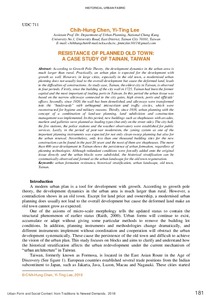Показать сокращенную информацию
RESISTANCE OF PLANNED OLD TOWN: A CASE STUDY OF TAINAN, TAIWAN
| Автор | Chih-Hung, Chen | |
| Автор | Yi-Ting, Lee | |
| Дата внесения | 2019-07-10T08:16:54Z | |
| Дата, когда ресурс стал доступен | 2019-07-10T08:16:54Z | |
| Дата публикации | 2019-05 | |
| ISBN | 978-5-7638-4127-5 | |
| URI (для ссылок/цитирований) | https://elib.sfu-kras.ru/handle/2311/111688 | |
| Описание | Proceedings of the XXV ISUF International Conference “Urban Form and Social Context: from Traditions to Newest Demands” (Krasnoyarsk, July 5–9, 2018) | ru_RU |
| Аннотация | According to Growth Pole Theory, the development dynamics in the urban area is much larger than rural. Practically, an urban plan is expected for the development with growth as well. However, in large cities, especially in the old town, a modernised urban planning does not usually lead to the overall development but cause the deformed land, leads to the difficulties of constructions. As study case, Tainan, the oldest city in Taiwan, is observed in four periods. Firstly, since the building of the city wall in 1725, Tainan had been the former capital and the most important of trading ports in Taiwan. In this period the urban tissue was based on the narrow alleyways connected to the city gates, high streets, ports and officials’ offices. Secondly, since 1920, the wall has been demolished, and alleyways were transformed into the “boulevards” with orthogonal intersection and traffic circles, which were reconstructed for hygiene and military reasons. Thirdly, since 1938, urban planning with the concept of a combination of land-use planning, land subdivision and construction management was implemented. In this period, new buildings such as shophouses with arcades, markets and galleries were planned as leading types (but only on the street side). The city hall, the fire stations, the police stations and the weather observatory were established for public services. Lastly, in the period of post-war modernism, the zoning system as one of the important planning instruments was expected for not only clean-sweep planning but also for the urban renewal. Nevertheless, only less than one thousand building sites for the new construction can be found in the past 20 years and the most of them are shophouses. The more than 400-year development in Tainan shows the persistence of urban formation, regardless of planning technologies. Although redundant conditions were forcedly added onto the original tissue directly and the urban blocks were subdivided, the historical stratification can be systematically observed and formed as the urban landscape for the old town regeneration. | ru_RU |
| Язык | en | ru_RU |
| Издатель | Siberian Federal University | ru_RU |
| Издатель | Сибирский федеральный университет | ru_RU |
| Тема | urban formation resistance, historical stratification, urban landscape, old town, Tainan. | ru_RU |
| Название | RESISTANCE OF PLANNED OLD TOWN: A CASE STUDY OF TAINAN, TAIWAN | ru_RU |
| Тип | Conference Item | ru_RU |
| Тип | Conference Paper | ru_RU |
| Контакты автора | Chih-Hung, C, Yi-Ting, L. : Assistant Prof. Dr. Department of Urban Planning, National Cheng Kung University No.1, University Road, East District, Tainan City 70101, Taiwan E-mail: chihhungchen@mail.ncku.edu.tw, jimmylee1011@gmail.com | ru_RU |
| Страницы | 181 – 190 | ru_RU |
| Место издания | Красноярск | ru |
| Место издания | Krasnoyarsk | en |

